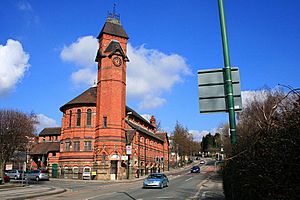Woodborough Road Baptist Church facts for kids
Quick facts for kids Woodborough Road Baptist Church |
|
|---|---|

Former Woodborough Road Baptist Church
|
|
| 52°57′45″N 1°08′46″W / 52.962496°N 1.146004°W | |
| OS grid reference | SK 57458 40919 |
| Country | England |
| Denomination | Baptist |
| Architecture | |
| Architect(s) | Watson Fothergill |
| Groundbreaking | 1893 |
| Completed | 1895 |
| Construction cost | £5,000 |
Woodborough Road Baptist Church is a historic building in Nottingham, England. It used to be a church for the Baptist community. Today, it is a special building that is protected because of its history and unique design. It is now used as a community center for the Pakistani community.
History of the Church Building
The people who started this church were originally part of another church called Stoney Street Baptist Church. In 1875, they decided to form their own group. By the early 1890s, they had enough money to build a new church.
They hired a famous architect named Watson Fothergill to design their new church on Woodborough Road. The building was started in 1893 and finished in 1895. It cost about £5,000 to build, which was a lot of money back then!
Opening Day and Design
The Woodborough Road Baptist Church officially opened its doors on February 5, 1895. It was a very impressive building for its time.
- The church had a large main hall, called a nave, with aisles on the sides.
- It could seat about 930 people in the main area and another 284 in the galleries (balconies).
- The inside walls were made of red brick, with blue and buff bricks used for decoration.
- The windows had small pieces of colored glass.
A very noticeable part of the church's outside design was its tall, eight-sided tower. This tower was 100 feet (about 30 meters) high and had clock faces on each side near the top. The outside was also made of red brick, with a strong stone base.
From Church to Community Center
Over time, fewer people attended the church. In the middle of the 20th century, the church eventually closed down. Around 1980, the building was changed to become a center for the Pakistani League of Friends. It is now known as a Pakistan Community Centre, serving as an important social hub for the community.

